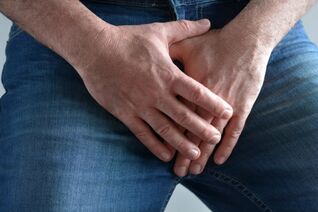
Prostatitis, like other diseases, manifests itself with certain symptoms. It is important for a man to know the first signs accurately, because they are a signal to see a doctor and for further examination. In this article, we will talk about the different forms of inflammation of the prostate gland and how first aid measures manifest themselves.
About short prostate and prostatitis
An adult man's prostate gland is a glandular organ consisting of two lobes and a capsule, as well as an adjacent prostate urethra. The prostate performs 3 functions at once:
- Regulates sperm density by producing prostate juice and diluting ejaculation with it.
- Blocks the urethra during orgasm.
- Participates in the production of certain hormones or controls their levels in the body.
If a man's reproductive system fails, the first symptoms will be related to these functions of the prostate.
After the entry or damage of pathogenic microflora to the prostate, hypothermia, as well as stagnant processes, inflammation begins. In this case, the blood microcirculation is disrupted, the flow of lymph, venous blood and prostate secretion deteriorates. This leads to the development of edema and enlargement of the gland. As a result, the tissues tighten, the man has a feeling of heaviness in the perineum, or a slight, aching pain in the lower abdomen - the first sign of an impending prostatitis.
The clinical picture will largely depend on the form of the inflammatory process and the causes.
Symptoms of Acute Bacterial Prostatitis
It is very difficult to miss the first signs of acute prostatitis - it appears suddenly and develops rapidly. It often takes 2-4 days between the onset of the inflammatory process and the first sign. In this case, the clinical picture will depend on the stage of the disease.
In this case, the clinical picture will depend on the stage of the disease.
Acute catarrhal inflammation
The first sign of this type of prostatitis will be a feeling of heaviness in the perineal area and an increase in urine output at night. Body temperature does not increase in this form, because men often ignore the existing problems or try to solve them on their own, thereby provoking the next stage.
Acute follicular inflammation
At this stage, the first signs of prostatitis are more pronounced. Many men no longer risk self-medication, but seek medical attention. Complaints will be very different:
- There is a dull pain in the perineum, which can spread to the coccyx or anus.
- Urine is painful, the man has difficulty, that is, acute urinary retention may develop.
- Pain during bowel movements due to the man's inability to go to the toilet.
These are the first symptoms of acute follicular prostatitis, in addition to which can be added fever up to 38 degrees, general depression, weakness, lethargy. The man becomes irritable, libido decreases, erectile dysfunction may appear.
These symptoms persist and develop in the absence of appropriate treatment.
Acute parenchymal inflammation
The inflammatory process is already spread to the parenchymal tissue, so it develops rapidly. The first thing a sick person will see is an increase in body temperature to high values (above 39 ° C), chills, dry mouth. The pain will be worse, throbbing, and can be felt in the perineum, as well as in the lower back, abdomen and genitals.
Urine will also change. A man will first see an intermittent flow and then will not empty his bladder at all due to severe pain. If you do not call an ambulance, there will be signs of indigestion - bloating, constipation, abdominal pain of different localization. Fetid mucus is discharged from the anus.
You can understand that parenchymal acute prostatitis begins with a characteristic feature: the pain is reduced if you lie on your back and lift your legs up. This is a clear signal that urgent medical attention is needed.
The first signs of chronic prostatitis

Chronic prostatitis is a long-term inflammation of the prostate gland, so the first symptoms begin in the most acute form. However, a man expects periods of exacerbation from time to time, and here you need to understand what symptoms will accompany it. Men often complain of the following health problems:
- Burning sensation around the glans penis, especially during ejaculation or urination;
- A small pain in the perineum may spread to the pubis;
- A slight increase in body temperature.
With chronic prostatitis, erection problems, as well as the ability to participate in the conception of a child, inevitably begin. This is due to the deterioration of prostate function, changes in the blood supply to the penis and the deterioration of sperm quality.
You should take a course of treatment at the first signs of prostatitis exacerbation. It is not recommended to use pills prescribed by a doctor without an initial examination.
Clinical manifestations of the disease
Regardless of the form of the inflammatory process and the reasons for it, a man will only have a trio of symptoms that differ in the intensity of their manifestations. Prostatitis is always accompanied by urinary dysfunction, pain and erectile dysfunction.
Prostatic urinary incontinence or intermittent flow. Sometimes the jet erupts and then it is problematic for the man to stand up and get rid of a small need. The urge to urinate is more frequent at night, especially in the morning. Urine may turn pink due to a mixture of blood with prostate stones.

With prostatitis, epithelium and other cells accumulate in the urethra, and bacteria can multiply. This causes a burning sensation that intensifies during urination or defecation.
Pain cannot be prevented. Depending on the severity of the pathological process, they may be:
- whine;
- stupid;
- shooting (pulsating).
Their most common localization is in the perineal region, slightly below the testicles. Radiation for the coccyx, sacrum, pubis, penis is not excluded. In addition, pain can occur in the anus, especially during pushing, because a man often suffers from constipation.
When it comes to body temperature, it rarely rises to 38 degrees. Exceptions are parenchymal and purulent prostatitis, where this figure can reach 40 degrees and can be accompanied by chills, severe depression and sometimes confusion. In such cases, the temperature with prostatitis is life-threatening.
first aid for prostatitis
If we are not talking about purulent processes, treatment of prostatitis is also possible on an outpatient basis. However, even in this case, it is impossible to do anything without consulting a doctor for the choice of examination and treatment tactics. However, the first signs of prostatitis can appear when a man is unable to call an ambulance, so it is necessary to know some principles of first aid.

- When the temperature rises above 38 degrees, you can take antipyretics.
- To relieve the pain, it is best to lie on your back and lift your legs as high as possible (leaning against a wall or furniture).
- You can include antispasmodics or suppositories, especially during severe pain.
You should consult a doctor as soon as possible, tell what medications you are taking and in what dose.
Traditional methods can be used only after the diagnosis is confirmed and only with the permission of the attending physician.
How prostatitis manifests itself in tests
Prostatitis refers only to diseases that do not have their own symptoms. For example, a burning sensation during urination may be urethritis, and pain in the abdomen may be accompanied by appendicitis or cystitis. Therefore, the final diagnosis is made not on the basis of the patient's complaints, but on the basis of laboratory tests of blood, urine, semen and prostate fluid. Information on rectal examination, TRUS and a number of other instrumental methods are also taken into account.
The following diagnostic features are characteristic of prostatitis:
- Presence of bacteria or fungi in urine and prostate fluid. Presence of leukocytes in urine and blood tests.
- Decrease in the number of leukocytes against the background of an increase in the number of leukocytes in prostate secretion;
- Blood in urine or semen;
- Decreased erythrocyte sedimentation rate in blood tests.
- Pain on palpation of the prostate, changes in size and consistency.
- According to TRUS results, echogenicity, granularity, change in contour.
The combination of these symptoms with well-being complaints allows us to make an accurate diagnosis, which means that the treatment will be prescribed correctly. The patient's quality of life, speed of recovery and, in some cases, life depends on it.
Result
Knowing the first signs of prostatitis in men, you can monitor changes in well-being in a timely manner and take action in advance. If pain begins in the perineum, urine flow is reduced, and urination is frequent - this is a reason to suspect inflammation of the prostate and a signal to see a doctor. In these cases, it is better not to treat yourself.
























